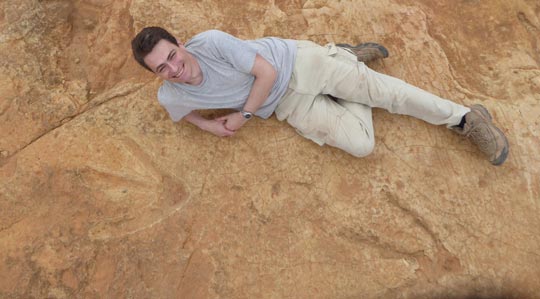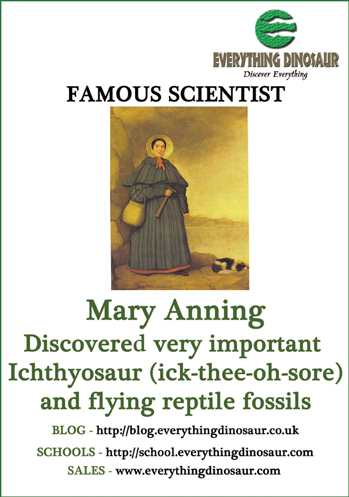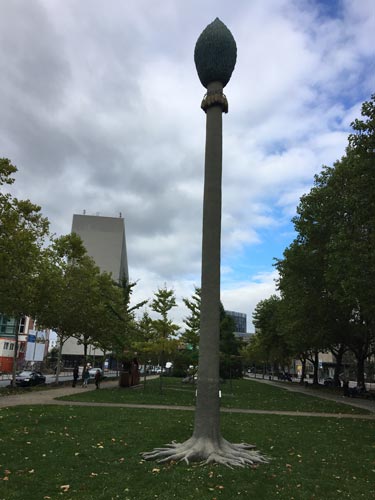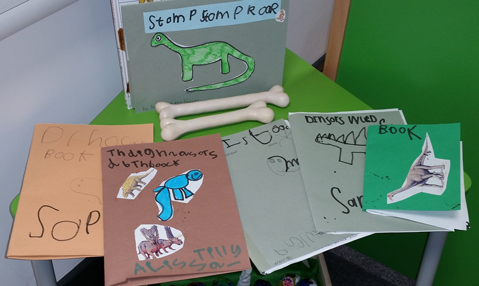Kayentapus ambrokholohali – Taking Giant Dinosaurs in our Stride
A team of international scientists, including researchers from Manchester University, have published a paper in the academic journal PLOS One that reports on the discovery of giant, three-toed dinosaur tracks in the Maseru district of Lesotho, southern Africa. These tracks, some of which measure 57 centimetres long, are the first evidence of the existence of huge, apex theropods in the Early Jurassic of southern Gondwana. The prints have been assigned to the ichnogenus Kayentapus and a new species – Kayentapus ambrokholohali has been erected.
University of Manchester Senior Research Fellow Dr Fabien Knoll Reclines Next to the Giant Dinosaur Tracks

Dr Fabien Knoll (Manchester University) poses next to the dinosaur trace fossils.
Picture credit: Manchester University
The Largest Known Theropod Tracks in Africa (Kayentapus ambrokholohali)
The tracks were found in fine-grained sandstone, that was laid down some 200 million years ago, the surface (palaeosurface), shows current-ripple marks and desiccation marks indicating that the surface represents an environment close to a river or lake (fluvio-lacustrine environment). The tracks indicate that a large, three-toed dinosaur with a pace length in excess of 1.3 metres walked across the wet sand, perhaps it had come to the area to get a drink or perhaps to find prey. The scientists which include Dr Fabien Knoll (Manchester University) and Dr Lara Sciscio, (postdoctoral Research Fellow at the University of Cape Town), state that the trace fossils come from deposits representing the Upper Elliot Formation, a formation that is synonymous with abundant vertebrate trackways but very few body fossils. The tracks are the largest theropod dinosaur footprints to have been described from African rocks to date.
An Apex Predator
The tracks suggest an apex predator (Megatheropod), a dinosaur which would have been around 8-9 metres in length, much larger than many of the contemporary theropods known from the Early Jurassic. The prints don’t give any idea of the dinosaur’s age, unlike histological analysis of fossil bone, this giant, might not have been fully grown! The dinosaur has been named Kayentapus ambrokholohali as the long-toed prints resemble those from the ichnogenus Kayentapus, a widely distributed ichnogenus with a substantial chronological and geological time span.
A Scale Drawing of the Theropod Dinosaur (Track Maker)

A scale drawing based on the Lesotho tridactyl dinosaur prints.
Picture credit: University of Manchester/Press Association
Dr Sciscio commented:
“This discovery marks the first occurrence of very large carnivorous dinosaurs in the Early Jurassic of Gondwana, the prehistoric continent which would later break up and become Africa and other landmasses. This makes it a significant find. Globally, these large tracks are very rare. There is only one other known site similar in age and sized tracks, which is in Poland”.
Comparative Line Drawings of Lower Jurassic Track D1 from Lesotho and Other Large Theropod Tracks from the Jurassic and Cretaceous

Comparative dinosaur tracks (line drawings).
Picture credit: PLOS One
Studying the Tracks
A comparative analysis of three-toed dinosaur tracks from various locations (Jurassic and Cretaceous trackways).
The line drawings above show (A) Kayentapus hopii, Kayenta Formation (Early Jurassic), (B) a 35 cm long Eubrontes isp. (C) a 39 cm long Kayentapus minor print, whilst (D–E) represent Megalosauripus and a large Polish theropod track from the Sołtyków site, Poland. Drawings (F–G) represent Eubrontes cf., from the Middle Jurassic of Australia and (H) has been tentatively assigned to the ichnogenus Eubrontes glenrosensis, from the Lower Cretaceous Glen Rose Formation (United States). (I) represents Irenesauripus whilst (J) is a line drawing of Irenesauripus mclearni. Drawing (K) is Irenesauripus acutus, I, J and K are all from within the Albian Gething Formation of Canada. Track (L) in red, is print reference D1 (Kayentapus ambrokholohali) from the newly described Lesotho tracks.
All images have been redrawn and scaled to 15 cm.
Dr Knoll added:
“In South Africa, Lesotho, Zimbabwe and Namibia, there is good record of theropod footprints from the Late Triassic and Early Jurassic epochs. In fact, there are numerous palaeosurfaces where footprints and even tail and body impressions of these, and other animals, can be found. But now we have evidence this region of Africa was also home to a mega-carnivore.”
The scientific paper: “The First Megatheropod Tracks from the Lower Jurassic Upper Elliot Formation, Karoo Basin, Lesotho” by L. Sciscio , E. M. Bordy, M. Abrahams, F. Knoll, B. W. McPhee and published in the journal PLOS One.
Everything Dinosaur acknowledges the help of a press release from Manchester University in the compilation of this article.
Visit the Everything Dinosaur website: Everything Dinosaur.












